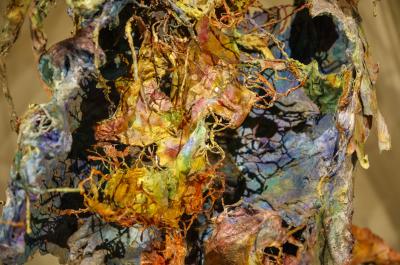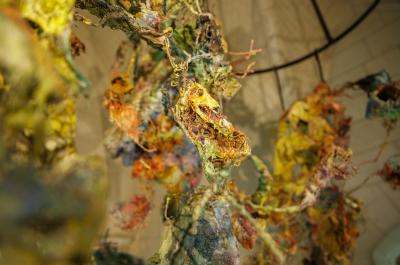A. Bernard Schultze
"Sculptures végétales"

Bernard Schultze (1915-2005) was one of Europe’s leading practitioners of gestural abstraction. In1952, he founded the Quadriga group of artists along with Karl Otto Götz (1914-2017), Otto Greis (1913-2001) and Heinz Kreutz (1923-2016), inaugurating “Informal Art” in Germany. In the early years of his career, he adopted André Breton’s point of view, according to which creative processes must be guided by the unconscious, which led him to develop a unique pictorial vocabulary in resonance with other artistic practices prevalent in the first half of the 20th century and an existential aesthetic of destruction reflected in tattered, distorted structures and colours evocative of wounds and decomposition, certainly connected with his own experience of war.
“Around 1957, Bernard Schultze started to introduce a variety of materials into his paintings, including straw, scraps of fabric and bits of string, which were initially stuck inside the pictorial matter but which gradually escaped from it to give rise to curious “reliefs”. These would soon dispense with frames and almost with substrates: a light wire mesh or flimsy framework of branches or wire was enough to piece together these fragile, fragmentary constructions that seemed to be consumed from within by some horrible disease, and which sometimes descended from the wall and occasionally reached right down to the ground. But the fresh, cheerful, flowery colours that Schultze employed in his works were there to establish (not without humour) the equivocal nature of those fantastical baroque creations, those morbid blooms proliferating like Ionesco’s mushrooms. Drawings and collages from this period are in the same acidic and sickly-sweet hues, serving an extreme finesse and acuity of line. After two solo exhibitions in Paris in 1958 and 1962 (Daniel Cordier Gallery), Schultze went on to create a sort of mythical character, Migof, pretext for and subject of the baroque festivities that would soon spread across space, taking over whole rooms at a time. Over the course of the 1970s, Schultze produced a series of paintings that included zoomorphic figures drawn from Greek mythology, along with landscapes in pastel shades, in oil and watercolours. In 1978, he presented a Migof environment in Hamburg, composed of several rooms.” (Larousse Dictionary of Painting)
Marked by their gestural abstraction, the works by Bernard Schultze on exhibition at the Domain of Chaumont-sur-Loire flaunt the fluorescent colours characteristic of the artist’s palette (green, orange, red and blue). Emerging from the walls as if they were escaping from an invisible elsewhere, the sculpture-paintings, whose materials have been made homogeneous by the artist’s hand, unfurl in space like organic forms, composing fantastical abstract landscapes.
Bernard Schultze’s works feature in a great many collections across the world, including at the Ludwig Museum in Cologne, the Museum of Modern Art in Céret, the Centre Pompidou in Paris, the Tate Collection in London, the Boijmans Van Beuningen Museum in Rotterdam and the MoMA in New York.
The sculptures and mobiles on exhibition at Château of Chaumont-sur-Loire are works of extraordinary chromatic poetry.
BIOGRAPHICAL NOTES

Bernard Schultze (1915-2005) was a painter, a leading figure in German Informal Art. He was born in Schneidemühl (East Prussia) and was 6 years old when he moved to Berlin, where his father held judicial office. When he was 19, he enrolled at Berlin’s Academy of Art Education and at the Academy of Fine Arts in Düsseldorf. After graduating in 1939, he was sent to the front, in Russia and Africa, where he was to say until the end of the war. After spending two years in Flensburg as a refugee, he joined his father, who had been appointed senior judge at the Frankfurt court. In autumn 1949, he made the acquaintance of the artist Ursula Bluhm at the Franck Gallery, whom he married 6 years later. In 1951, Bernard Schultze, whose early works had been destroyed when Berlin was bombed in 1944, produced his first informal paintings and paid his first visit to Paris, where he later stayed at regular intervals.
On 11 December 1952, Klaus Franck inaugurated the Neuexpressionisten (New Expressionists) exhibition at his gallery in Frankfurt, with thirteen works by Bernard Schultze, Karl Otto Götz, Heinz Kreutz and Otto Greis. Inspired by a poem written by René Hinds to mark the occasion, the critic renamed the group and the exhibition itself “Quadriga”. Producing colourful, highly gestural paintings, the four artists wanted to break with figuration and formalist abstraction and join the international avant-garde movements of Action Painting, Lyrical Abstraction and Tachism. Quadriga was responsible for the breakthrough of German Informal Art as a dominant artistic movement in the 1950s, even though the four protagonists soon developed very different styles.
In1954, Bernard Schultze starting including pieces of plastic in his paintings, a practice that was to lead to his first paintings in relief (1956). In 1961, the artist came up with the concept of “Migof”, which became a generic term in his body of work, denoting a “plastic being” created by assemblages/collages of shapes and objects. In 1964, he paid his first visit to New York, where he took a particular interest in Abstract Expressionism and Pop Art. The same year, he created his first Migof environment for Documenta III, filling an entire room. The first Migof bronzes made their appearance in its aftermath. Following his second visit to the United States, he added freestanding mannequins created out of coloured plastics to his forms of expression, an observation on the consumer society. After spending some time at the Cité des Arts in Paris, the painter moved to Cologne, which awarded him the city’s Art Prize in 1969. Bernard Schultze continued with his explorations, travelling to the Soviet Union, Ceylon, Thailand, Burma, Mexico, Guatemala, Hong Kong, Bali and Singapore, without ever forgetting to return to Paris at regular intervals.
In 1972, he was elected to Berlin’s Academy of Fine Arts. For two years (1980-1981), a major retrospective of his work made the rounds in Germany (Düsseldorf, Berlin, Frankfurt and Saarbrucken). In the 1980s and beyond, the painter was awarded numerous prizes and held numerous exhibitions, including one devoted to his works on paper at the Albertina in Vienna (1984). The end of the decade also saw his first large-format oil paintings, which could reach sizes of up to 15 m2, in which he soon introduced (1991) “tabuskri”, intersections of painting and graphic structures. During the years that followed, the artist worked on developing large-format bronzes and etchings. In 1995, he moved to Rue du Cygne in Paris, which became his second home. Thenceforth, he divided his life between Paris and Cologne, where he died on 14 April 2005, a few weeks before his 90th birthday.


